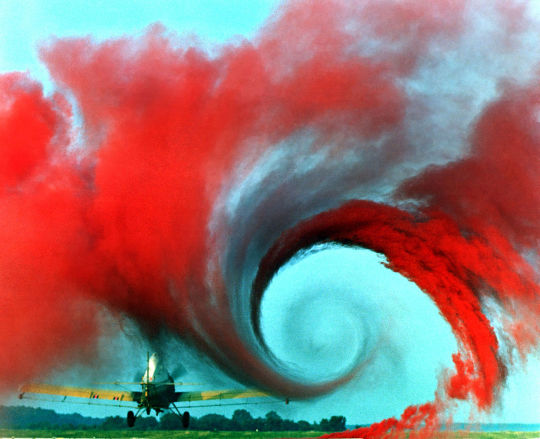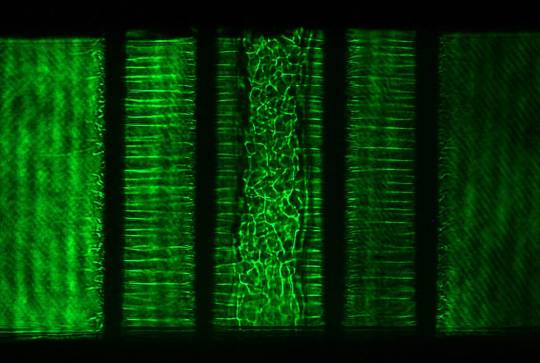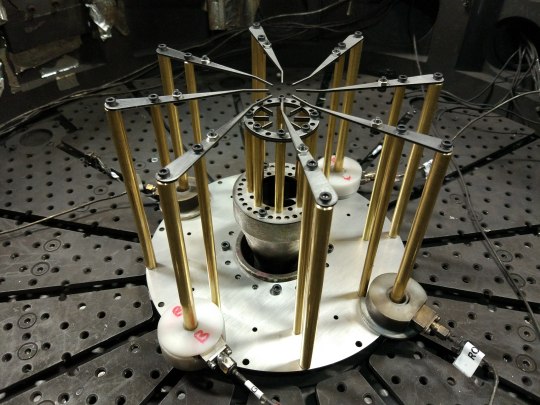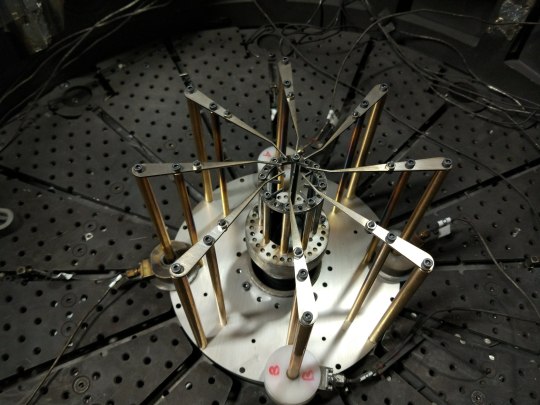My last blog post focused on new hardware for magnetic reconnection experiments. Since then, I’ve published two new papers (available here and here) using this hardware, as well as an improved version which allows us to study reconnection whilst varying the plasma density and magnetic field strength.

Wake Vortex Study at Wallops Island. Langley Research Centre, NASA: Public Domain
Although there’s plenty to do with reconnection, I’m also getting increasingly interested in magnetised turbulence in plasmas. Turbulence in fluids is one of the most challenging areas of research across engineering and physics, with billions of dollars spent understanding how it effects things such as aeroplanes, wind turbines and F1 cars.
If you chuck in magnetic fields, compressibility and fast moving charged particles the problem of turbulence becomes significantly harder, but we need these extra ingredients to extend theories of turbulence to astrophysical objects like accretion disks around black holes, the chemistry of the interstellar medium (in which stars like our sun are formed), and other fascinating and complex objects we observe throughout the universe. It’s actually pretty hard to make a plasma which isn’t turbulent!
To this end, I’ve started designing some new experiments to try and create a turbulent plasma which is easy to diagnose. This is a key requirement – there’s no point making a turbulent plasma if we can’t measure it.

In the first year of my PhD I carried out some initial experiments using carbon wires (pencil leads!) in an imploding wire array. The resulting column of plasma was fascinating – highly unstable, with features on all resolvable length scales. We didn’t fully understand what was going on this picture, but as it won a prize in the annual EPSRC science photo competition, and I wrote a blog post about it that seemed like enough at the time – I moved on to other research ideas, eventually settling on reconnection.
All good ideas have been done before, and in October we met up with our collaborator Nuno Loureiro, from MIT, and he suggested a turbulence experiment. We dusted off this image and started chatting about how we’d actually measure turbulence – what is it we want to know, can we measure it and would anyone care?
Well, I have no idea whether anyone will care, but we can make a start on the other two points. I won’t talk about our new diagnostic technique in this blog post – not only is it unpublished, but we also not quite sure how to analyse the results yet! Still, the old experiment clearly needed some improvements to allow us to make better measurements, and to this end I designed some entirely new hardware.
I have a reputation in my research group for being obsessed with the laser cutter, and for good reason – it’s an incredible way to make things. You draw a shape, and the laser cuts it out of 1.5 mm thick stainless steel. And it does so quickly and cheaply. As opposed to waiting weeks for components to be meticulously machined, we can get the parts back the same day, or even over a lunch break. The laser doesn’t care what shape you draw, so you can go wild with beautiful curves and precise alignments which would be very difficult to do with standard machining techniques. At least part of my obsession with the laser cutter is the incredible aesthetics it makes possible, and so my latest design looks like an exploding flower or the maw of some horrific sea creature:

Well, that’s how it looks as a render. In reality, MAGPIE is a bit more grimy:

Still, not bad! At heart, there are eight vertical carbon rods, arranged in a circle. Current passes up the sets of brass posts around the outside of the array, passes along the long bendy horizontal metal struts, down the carbon rods and then the inner set of brass rods to the solid lump of metal in the centre of the image.
The beauty of laser cutting is that components become disposable. I’d expected this to be completely destroyed after the shot, but actually it’s only a little burnt:

I managed to get seven imaging diagnostics onto this shot, which was a lot of work, but the results look very nice:

You can see eight converging streams of plasma, about to collide at the centre of the image. The stripy pattern is due to interference fringes – this diagnostic is a Mach Zehnder imaging interferometer, and the fringes are bent in regions where there is plasma.
The data from today’s experiment reproduces our previous experiments, which suggests that this new platform should allow us to make a turbulent plasma column. The next step is to repeat the experiment to look at later times (when the streams have arrived at the centre of the image) and determine when turbulence sets in. Then we need to get even more diagnostics and see what we can learn!
